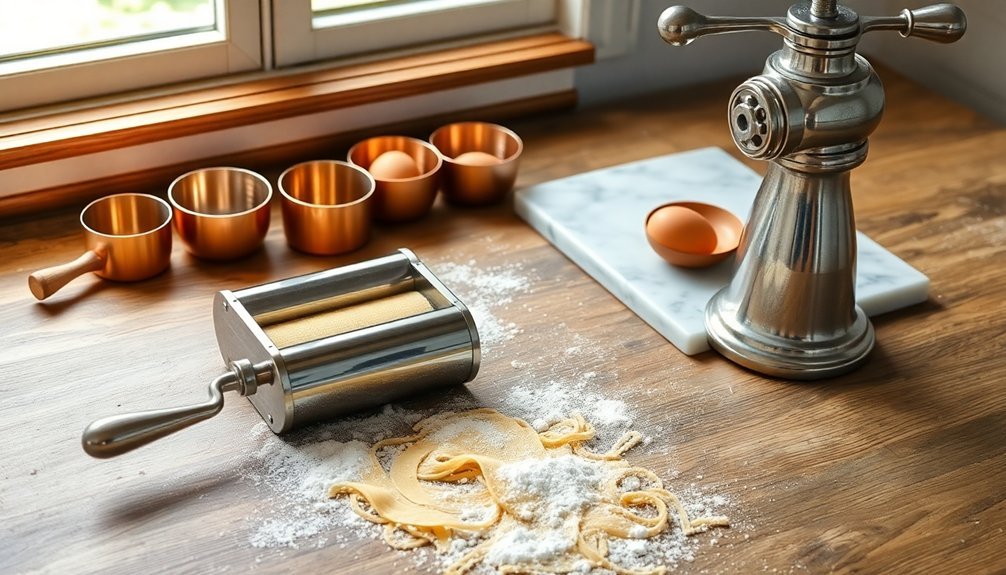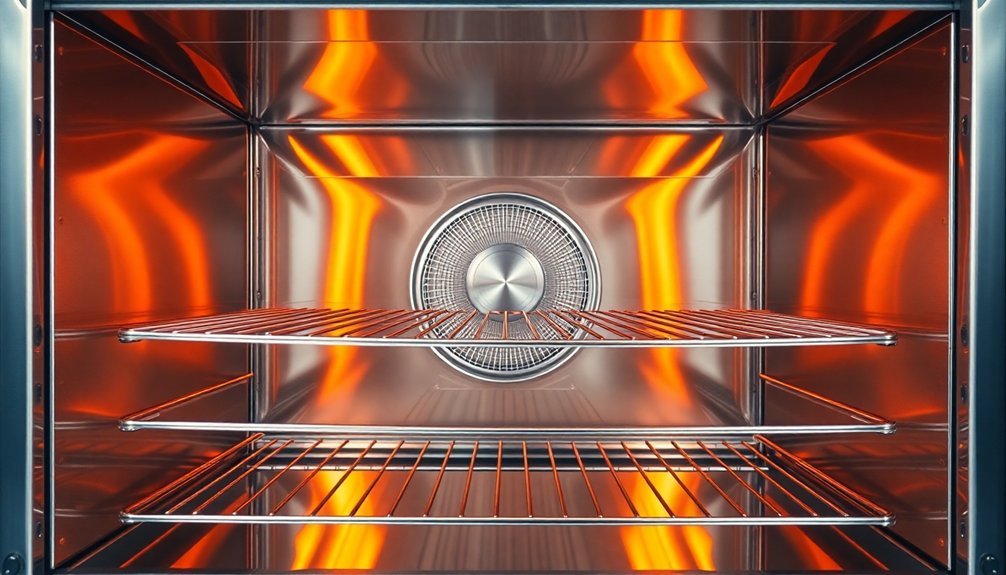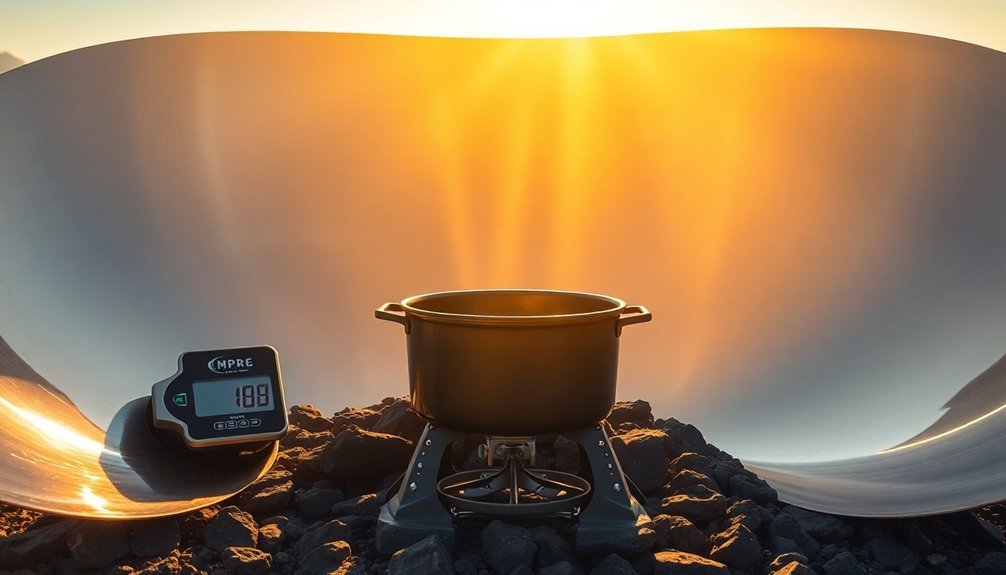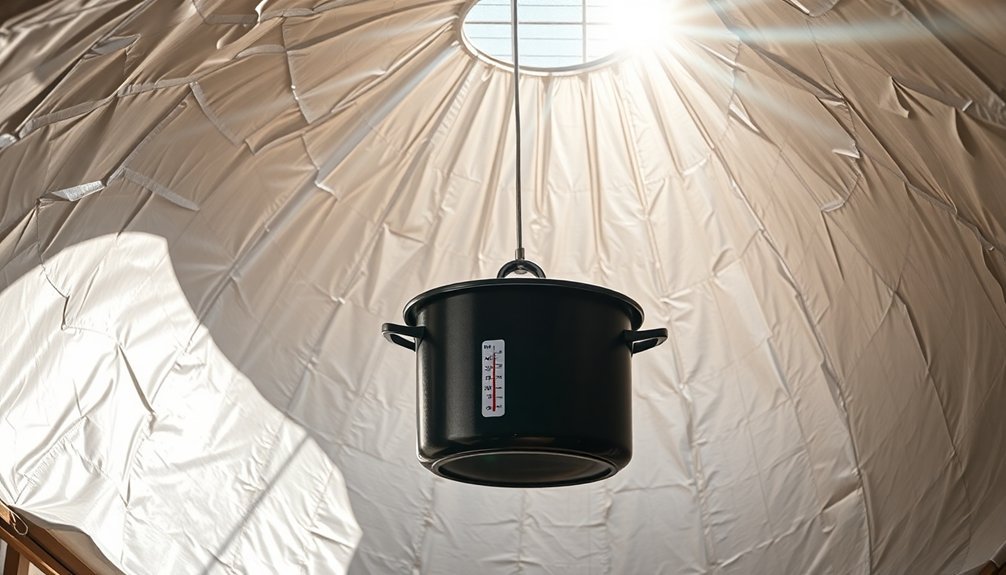You can prepare delicious pasta without electricity using alternative heat sources like solar cookers, campfires, or gas stoves. Start by selecting sturdy pasta shapes like bucatini or fettuccine, and measure about 2-3 ounces per person. You'll need a large pot filled with cold water (use 10 times the pasta's weight), a sturdy colander, and basic utensils. Maintain water temperature above 180°F for proper cooking, stirring regularly to prevent clumping. For sauce, combine fresh ingredients like tomatoes, basil, and olive oil, letting them marinate at room temperature. With proper tools and techniques, there's much more to discover about crafting the perfect electricity-free pasta dish.
Essential Tools and Equipment

While cooking pasta without electricity might seem challenging, having the right tools and equipment makes the process straightforward and manageable.
You'll need a large pot that's compatible with alternative heat sources like gas camping stoves or wood-burning stoves. Make sure to have a sturdy colander or strainer for draining your pasta once it's cooked.
Essential utensils include a long-handled spoon for stirring, a ladle for serving sauce, and a spatula for preventing pasta from sticking to the pot's bottom. The Marcato Atlas 150 is an excellent manual pasta maker option that can achieve ultra-thin pasta sheets without requiring power.
If you're making fresh pasta, you'll want a manual pasta machine or rolling pin for the dough. For wood-burning setups, keep seasoned wood and fire-starting tools nearby.
Don't forget basic serving utensils like forks and spoons to complete your pasta preparation toolkit.
Pasta Selection and Amount Needed
When preparing pasta without electricity, you'll want to select dried pasta varieties, which have a longer shelf life of up to two years and don't require refrigeration.
For your emergency food supply, stick to basic shapes like spaghetti or penne, calculating about 2-3 ounces of dried pasta per person for a satisfying portion. Cold soaking techniques work particularly well with these pasta shapes when traditional cooking methods aren't available.
You can efficiently portion and store your pasta supply in airtight containers, making sure to check expiration dates and maintain proper storage conditions to preserve quality.
Choosing Long-Lasting Pasta Types
Since preparing pasta without electricity requires careful consideration of durability and cooking time, choosing the right pasta type becomes essential for success. Opt for sturdy varieties like bucatini and fettuccini, which can withstand manual cooking methods without breaking. These shapes also excel at holding sauces, making your meal more satisfying.
While spaghetti's versatility is appealing, thicker options like bigoli offer better durability for non-electric cooking. The climate of Naples' ideal conditions historically proved perfect for air-drying pasta, showing how these heartier varieties were designed to last. If you're looking for quick-cooking alternatives, consider fedelini or capellini, though they'll need careful handling to prevent clumping.
For heartier meals, pappardelle and tagliatelle are excellent choices – their robust nature helps them maintain structure during manual cooking while still capturing substantial sauces effectively.
Avoid very delicate pasta shapes that might fall apart during the extended cooking process without controlled heat.
Calculating Per-Person Portions
Once you've selected your preferred pasta type, getting the portions right guarantees everyone gets enough to eat without wasting precious supplies.
For long pasta like spaghetti or linguine, measure 90 grams (about 2 ounces) per person. This'll double in size when cooked, providing a satisfying 180-gram serving.
If you're using short pasta shapes like penne or farfalle, you'll need 75 grams per person, roughly two handfuls.
For specialty pastas, adjust accordingly: fresh pasta requires 120-150 grams, while gnocchi needs 100-130 grams per serving. Filled pasta like ravioli or tortellini also needs 120-150 grams per person.
When measuring without a scale, use these quick references: two handfuls for short pasta, or enough long pasta to form a circle the size of a quarter when bunched together.
Water Temperature Control Tips

To achieve perfectly cooked pasta without electricity, controlling water temperature is essential throughout the cooking process.
Start with cold water, filling your pot with at least 10 times the weight of your pasta. Once you've reached a vigorous boil using your alternative heat source, maintain the temperature above 180°F for proper cooking.
When you add the pasta, you'll notice a temporary temperature drop. Don't worry – if you're using enough water, it'll recover quickly.
Keep the water at a rolling boil if possible, as this prevents sticking and guarantees even cooking. If you can't maintain a full boil, make sure the water stays hot enough to cook effectively.
Remove the lid while cooking to prevent overheating, and stir regularly to keep the pasta from clumping together.
Setting Up Your Cooking Area
Before diving into pasta preparation, you'll need a well-organized cooking station that prioritizes both safety and efficiency.
Select a level, stable area away from flammable materials to set up your heat source, whether it's a campfire, camping stove, or rocket stove.
Keep your cooking equipment within arm's reach, including a thick-bottomed pot, long-handled utensils for stirring, and tools like a spider or tongs for pasta handling.
Position a water source nearby for easy pot filling, and arrange your ingredients – pasta, olive oil, garlic, and seasonings – in a logical sequence of use.
If you're planning to serve immediately, designate a clean, dry area for plating.
Remember to have any additional ingredients, such as pre-cooked proteins or fresh herbs, prepped and ready to incorporate into your final dish.
Solar Cooking Safety Measures

When using a solar cooker, you'll need to protect your eyes and skin from harmful UV radiation by wearing sunglasses and applying sunscreen.
You should monitor your pasta's cooking temperature with a reliable digital probe thermometer, ensuring it stays between 180°F and 250°F for safe consumption.
It's essential to maintain these temperatures throughout the cooking process by adjusting the cooker's position to track the sun's movement.
Protect From UV Rays
Safety should be your top priority when using a solar cooker, particularly regarding UV ray protection. When cooking pasta using solar power, you'll need to protect your eyes and skin from reflected sunlight. While brief exposure won't cause permanent damage, it's similar to sunlight flickering through trees and can be uncomfortable.
| Protection Type | What to Do | Why It Matters |
|---|---|---|
| Eye Safety | Wear protective eyewear | Prevents discomfort from reflections |
| Position Safety | Face cooker away from paths | Avoids accidental exposure |
| Storage Safety | Store mirror-down | Prevents unintended reflections |
Position your cooker carefully to prevent accidental reflections, and make sure children understand the potential hazards. Keep the cooker stable and secure, and always store it with the reflective surface facing downward when not in use.
Monitor Temperature Control
Beyond protecting yourself from UV rays, maintaining proper temperature control serves as the backbone of successful solar pasta cooking.
You'll need a calibrated thermometer that reads up to 100°C to monitor your cooking temperatures effectively. Keep checking internal temperatures regularly, aiming to maintain heat above 125°F, ideally between 150-225°F.
To prevent bacterial growth, don't let your pasta remain in the danger zone (50-125°F). Use dark-colored cookware with tight-fitting lids to maximize heat retention, and reposition your solar cooker every 30-45 minutes to follow the sun's path.
Make certain your cooking cavity is well-insulated with materials like crumpled newspaper or dry leaves, and incorporate reflective surfaces to enhance heat retention. Choose a clear, sunny day and a sheltered spot to achieve the best cooking temperatures.
Alternative Heat Source Methods
In an emergency without electricity, several reliable heat sources can help you prepare pasta successfully. When using a campfire, place your pot on a sturdy grate and start with aromatics like peppers and onions before adding your pasta.
Gas or camping stoves offer portable alternatives that give you precise temperature control with propane or butane fuel.
For eco-conscious cooking, you'll find these effective options:
- Solar cookers that harness sunlight to heat your pasta water
- Wood-burning stoves using seasoned wood for consistent heat
- Homemade rocket stoves crafted from tin cans or bricks
- Traditional campfires with proper grating and pot placement
Each method requires different timing and attention to heat management, but they'll all get your pasta cooked properly when electricity isn't available.
Remember to stir frequently and keep the water at a steady boil.
Checking Pasta Doneness Without Power

Determining pasta doneness without electricity requires reliable visual and tactile testing methods. You'll need to rely on your senses and observation skills to guarantee your pasta is perfectly cooked. Look for translucency and swelling as key indicators that your pasta is ready.
| Visual Cues | Touch Tests |
|---|---|
| Translucent appearance | Smooth texture |
| Increased size | Fork slides easily |
| Even coloring | Firm but not hard |
| Pliable shape | No grittiness |
| Consistent swelling | Gentle resistance |
Test the pasta's texture by biting into a piece – it should be al dente with slight firmness in the center. If you're using a thermal cooker or passive cooking method, remember that residual heat continues cooking the pasta, so check it a minute or two before the recommended time. Keep the lid on to maintain heat and guarantee even cooking throughout.
Sauce Preparation Without Heat
Creating delicious pasta sauce doesn't always require heat or electricity. You'll need fresh ingredients like heirloom tomatoes, basil, garlic, and high-quality olive oil to make a flavorful cold sauce.
Simply chop and combine these ingredients in a large bowl, season with salt and pepper, and let them marinate at room temperature for at least 4 hours.
For the best cold sauce experience:
- Use the freshest ingredients available, especially during summer months
- Let ingredients marinate properly to develop deep flavors
- Adjust seasoning right before serving
- Pair with appropriate pasta types like cappellini or cheese ravioli
You can customize your sauce by adding different herbs or grated Parmesan cheese.
The versatility of cold sauces means you can serve them immediately with hot pasta or use them in invigorating pasta salads.
Storing Without Refrigeration

While modern storage methods often rely on refrigeration, properly dried pasta can last for months when stored correctly at room temperature. You'll want to dry your pasta until it snaps easily, which typically takes 12-24 hours. Lay it in a single layer on a baking sheet or use a drying rack for longer strands.
| Storage Method | Duration | Key Tips |
|---|---|---|
| Room Temperature | 2-6 months | Airtight container, dry area |
| Freezer Storage | 8 months | Form into nests, remove air |
| Drying Rack | 12-24 hours | Single layer, coat with flour |
Once dried, store your pasta in an airtight container away from sunlight and humidity. Don't forget to coat it with flour or semolina before storage to prevent sticking. If you're freezing portions, form them into nests and remove all air from the freezer bags before sealing.
Frequently Asked Questions
Can Pasta Be Cooked Using Thermal Cookers or Insulated Containers?
Yes, you can cook pasta using thermal cookers by initially boiling it briefly, then letting it finish cooking in the insulated container. You'll need to transfer the partially cooked pasta while it's still hot.
How Do You Measure Water Temperature Without a Thermometer?
You can measure water temperature by observing bubble patterns, listening to boiling sounds, and checking steam levels. Watch for tiny bubbles at 160°F, visible steam at 170°F, and large bubbles at 190°F.
What's the Best Way to Strain Pasta Outdoors?
You'll want to use a colander for straining pasta outdoors – it's stable, has plenty of drainage holes, and can handle large portions. Place it on a level surface and carefully pour your pasta through it.
Does Altitude Affect Pasta Cooking Time When Using Alternative Heat Sources?
Yes, your pasta's cooking time will increase at higher altitudes regardless of heat source. You'll need to add 15-20% more time because water boils at lower temperatures, affecting how quickly pasta cooks.
Can Pre-Soaking Pasta Reduce the Fuel Needed for Cooking?
Yes, you'll save significant fuel by pre-soaking pasta. When your pasta's already hydrated, you'll only need a brief heating period to cook it fully, using much less energy than traditional boiling methods.
In Summary
You've learned several ways to prepare tasty pasta without electricity, from solar cooking to alternative heat sources. By following proper safety measures and temperature control techniques, you'll still create delicious meals during power outages. Remember to store your pasta dishes correctly when there's no refrigeration available. With these methods, you're now prepared to cook pasta anytime, anywhere – no power needed.





Leave a Reply